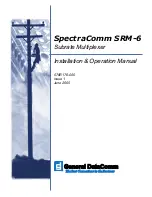
DM16E1 / DM4E1 Operation and Installation Manual - 204-4001-19
97
The monofiber optic aggregate cards of the DM16E1/DM4E1 transmit and receive using different
wavelengths. This presents several advantages regarding performance, range and reliability because
transmitted signal reflections do not affect reception. This also prevents the need for APC polished
connectors along the fiber length. However, different cards must be used in each side of the fiber for all
connections. For example, to connect devices A and B, if A uses a DM16E1-SSB13 card, B must use a
DM16E1-SSB15 card. Thus device A transmits at 1310 nm and device B receives also at 1310 nm.
Transmission from B is at 1550 nm and reception in A is also at 1550 nm. When operating with 1 + 1
protection, the ideal setup is one card at 1310 nm TX and another card at 1550 nm TX in each device.
Topology must be analyzed in order to obtain adequate optic connections. This will be detailed later.
15.3. DM16E1 / DM4E1 Mixed Operation
The DM4E1 model accepts the same aggregate cards as DM16E1. The aggregate link operates in E3 at
34 Mbits/s. DM4E1 must be seen as an E3 mux similar to DM16E1, except that there are only 4 available
E1 interfaces.
The DM4E1 can use any four E1 channels from the E3 aggregate to four E1 tributary ports and up to 12
E1 channels from the aggregate to the Ethernet
remote bridge. The V.35 and routing ports may also be
mapped to any E1 channel from the E3 aggregate while maintaining normal functionality of the 4 tributary
E1 (G.703) ports.
15.4. Point to Point Topology
Devices are factory preset for point to point topology so they do not need any additional settings when only
tributaries E1 (G.703) are used. Aggregate 1 is considered the main link and Aggregate 2 is the backup
link (with automatic backup). With this initial setup, other configurations can be made remotely except for
some SNMP management settings.
Connect power supply, tributaries, aggregates and Ethernet cable if necessary. When connecting the
aggregate, be careful to connect TX to RX when using two fibers and 1310 nm to 1550 nm cards when
using monofiber.
Figure 28. Connections in Point to Point topology
All devices should connect automatically if all connections are done correctly. Use the terminal connector
for configuration changes and to check the status of local or remote devices.
Refer to chapter 3 for additional information about configurations using the terminal port. SNMP setup is
detailed in item 13.2.
15.5. Unidirectional Ring Topology (Cascading)
This is an extremely economical topology because only one aggregate card is needed. However it does
not have a backup and does not support monofiber optic interfaces.
Extreme care must be taken when cleaning optic connections. Any kind of contaminant present in
receptacles or latches may considerably degrade equipment performance. Clean only with tissue for optic
connections.










































